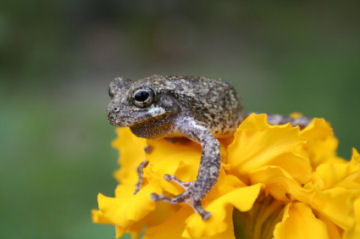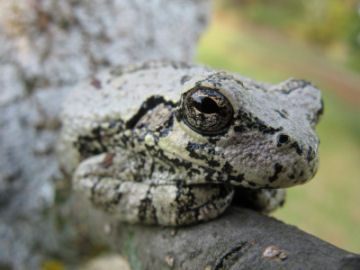Cacophony acoustics
How do frogs hear each other in a noisy pond? Just the way we would, as it turns out.
By Emily Sohn
You’re in the middle of a bustling school lunchroom. Some girls are yelling behind you. Right beside you, a boy is singing along with his iPod. Other kids are playing a rowdy game in the corner. Meanwhile, you are trying to talk to your friend across the table.
How can you single out one voice amid a sea of noise? You could call this “the loud lunchroom problem.”
Scientists have a different name for it. They call it “the cocktail party problem.” (After all, adults have the same problem hearing someone talk at a loud party as you do in a noisy lunchroom.)
 |
|
A noisy lunchroom can keep you from hearing your friends. Frogs and other animals face similar problems with noise.
|
| iStockphoto |
Luckily, most people can distinguish specific sounds from background noise quite well. And so can many animals. In a crowded pond, frogs find their croaking mates. On a packed glacier, penguins find their squawking babies. In a threatening situation, some monkeys use sound to tell each other whether to flee or attack. In nature, being able to distinguish specific sounds can sometimes be a matter of life and death.
Scientists don’t know exactly how these creatures do it, but they’re trying to find out.
“We can learn a great deal about the basic cocktail party problem by studying how other animals have evolved to solve their own cocktail party problems,” says behavioral biologist Mark Bee of the University of Minnesota, Twin Cities.
This research could lead to better hearing aids and to computers that can identify individual voices. Conservationists also hope that the insights gained from this work will help them protect species that are threatened by noise pollution.
Focusing on frogs
In his lab, Bee focuses on gray tree frogs. The adults of this species are only about 5 centimeters, or 2 inches, long. However, when a bunch of these tiny creatures croak together, their voices can be as loud as a truck roaring down a freeway. Male frogs use their voices to mark their territories, and females select mates based on the males’ calls.
 |
|
To understand the cocktail party problem, scientists study how gray tree frogs listen to each other’s calls.
|
| iStockphoto |
There are some 5,000 frog species, Bee says, and each one makes a different sound. A springtime frog chorus in a typical pond can include as many as two dozen species calling at once. “Most frogs communicate in cocktail party-like environments,” Bee says.
Croak and Croon
Every night, between the months of April and July, Bee and his colleagues collect pairs of mating frogs. Back in the lab, the researchers put the animals through a series of tests to measure how the females responded to the male frogs’ calls under a variety of conditions.
A frog begins each test in the center of a pitch-dark, circular chamber. Movable speakers pump out specific sounds. The sounds include both male frogs’ calls and background sounds that could drown out the calls. The scientists record which way the frogs hop in response to specific noises. (To “see” the frogs in the darkness, the scientists use video cameras that are equipped with heat-sensing infrared detectors.)
In one series of experiments, Bee tested female frogs to see whether distracting sounds would keep them from moving toward the recorded call of a male frog. Meanwhile, background noises came out of a second speaker. From one trial to the next, the researchers changed the volume and location of the speaker that emitted the male frog’s call. Meanwhile, the background sounds remained the same.
Not unexpectedly, results showed that females moved toward the male’s call more often when it was louder than the background noise and when the call and the other noise were coming from different directions. The same thing is true for people: It’s easier to hear a friend if she raises her voice or if she steps away from a noisy crowd.
 |
|
In experiments, the volume and direction that speakers faced affected how frogs responded to the sounds coming out of them.
|
| iStockphoto |
In a second round of tests, Bee played two mating songs at the same time. Each song came from a different speaker. One song came from a male of the same species as the female frog, and the other song came from a male of a different species. Results showed that the female frogs got better at picking out the calls of a male of their own species as the two male frogs’ sounds came from increasingly opposite directions.
In a final round of tests, Bee divided a mating song into two parts. He played each part through a different speaker. In this case, the female frogs tended to move toward the sound when the speakers were close together, simulating an unbroken song. When the speakers were placed farther apart, and the song sounded more disjointed, the females stopped responding.
 |
|
Telling a mate’s call apart from the sound of a dangerous predator could help this gray tree frog survive.
|
| iStockphoto |
Together, these studies suggest that frogs distinguish sounds in much the same way as humans do, Bee says. And since frogs are ancient animals—they’ve been hopping around since the time of the dinosaurs—the ability of animals to overcome the cocktail party problem probably evolved a long time ago too.
“When the sense of hearing first evolved,” Bee says, “it would’ve been a darn good thing to figure out which objects were predators, which were mates, and where they were.”
Too much noise
Human-generated sources of noise pollution, such as traffic, factories, and airplanes, have started to threaten the ability of some animals to communicate. What kinds of problems might noise pollution pose for them?
 |
|
Traffic is one source of noise pollution.
|
| iStockphoto |
The frogs that Bee is studying offer a good example. A female might normally hear a male’s mating call from as far away as 128 meters (420 feet), says Bee. But if there’s noisy traffic nearby, she must be within 8 m (26 feet) to hear him.
“These are very preliminary results,” Bee says. “We’re going to pursue it further.”
Party animals
Other animals are experts at the cocktail party problem, too, says psychologist Dick Fay of Loyola University in Chicago. Fay has proved that goldfish distinguish specific sounds from a confusing cacophony in the same way as humans do. Other researchers have found that starlings and some primates deal with background noise in the same way.
“The more I look at domesticated animals like cats and dogs, the more I see that they respond to the world the way I do,” Fay says. Our ears are constantly working to give us a better sense of what’s going on around us. Animals’ ears are doing the same thing. “They’ve got to be hearing everything” the same way as we do, says Fay.
So what exactly does the world sound like to a frog, to a bird, or to your dog? As research continues, we may some day have an answer.
Going Deeper:







